 Seeds and Germination
Seeds and Germination
 Grow Setup
Grow Setup
 Seedling Stage
Seedling Stage
 Vegetative Growth
Vegetative Growth
 Pre-flowering
Pre-flowering
 Flowering
Flowering
 Ripening
Ripening
 Harvesting
Harvesting
 Drying
Drying
 Curing
Curing
 Troubleshooting
Troubleshooting
 Training Techniques
Training Techniques
A Comprehensive Guide to the Vegetative Stage of Cannabis
 15 Minute Read
15 Minute Read
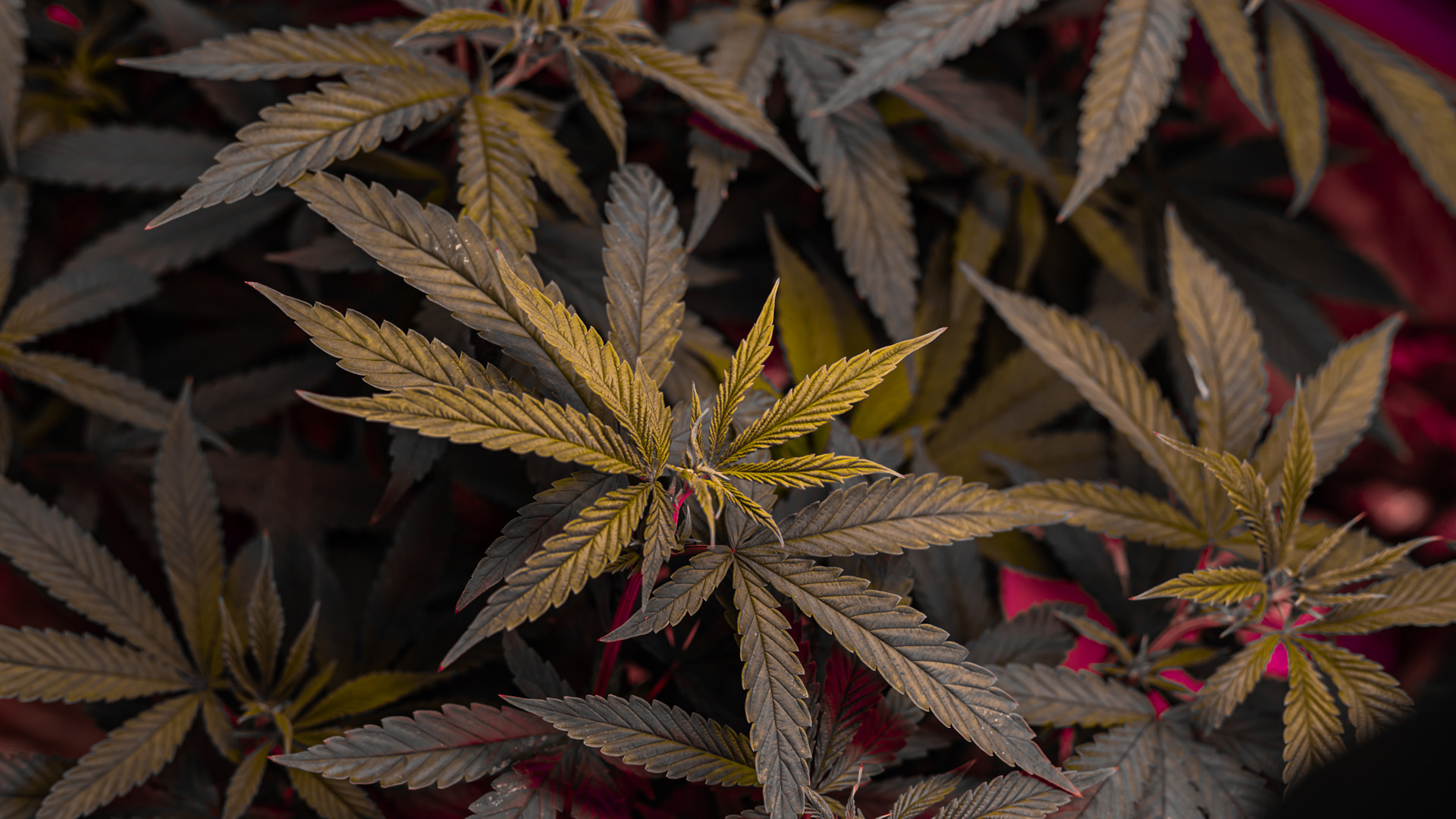
PUBLISHED: July 30, 2024
Cannabis cultivation is as much an art as it is a science, requiring growers to carefully manage various stages in the plant’s life cycle to achieve the best possible yield. Among these stages, the vegetative phase stands out as a pivotal period where cannabis plants lay the foundation for future flowering and overall productivity. Understanding and mastering the vegetative stage is crucial to maximize plant health, growth, and ultimately, the potency and yield of your harvest.
In this guide, we will delve deep into the intricacies of the vegetative stage, offering detailed insights, tips, and best practices to help you grow strong, resilient, and bountiful cannabis plants. This guide is designed for both novice and experienced growers who are serious about achieving top-tier results.
Laying the Foundations for Success in the Vegetative Stage
The vegetative stage of cannabis growth is the period following germination and seedling development, where the plant focuses primarily on growing leaves, stems, and roots. It’s the stage where cannabis plants establish the structural and physiological components that will support bud production later on. Much like how an athlete needs to train rigorously before a competition, cannabis plants use the vegetative stage to prepare for the demanding flowering phase.
Duration of the Vegetative Phase
The length of the vegetative phase can vary widely depending on several factors, including the strain (or cultivar), the method of cultivation, and the grower’s goals. Typically, the vegetative stage lasts anywhere from 3 to 16 weeks, but in some cases, it can extend even longer. By the end of this stage, cannabis plants will have developed a robust root system, strong stems, a sufficient number of nodes, and a dense canopy of large fan leaves—essential for capturing light and driving photosynthesis.
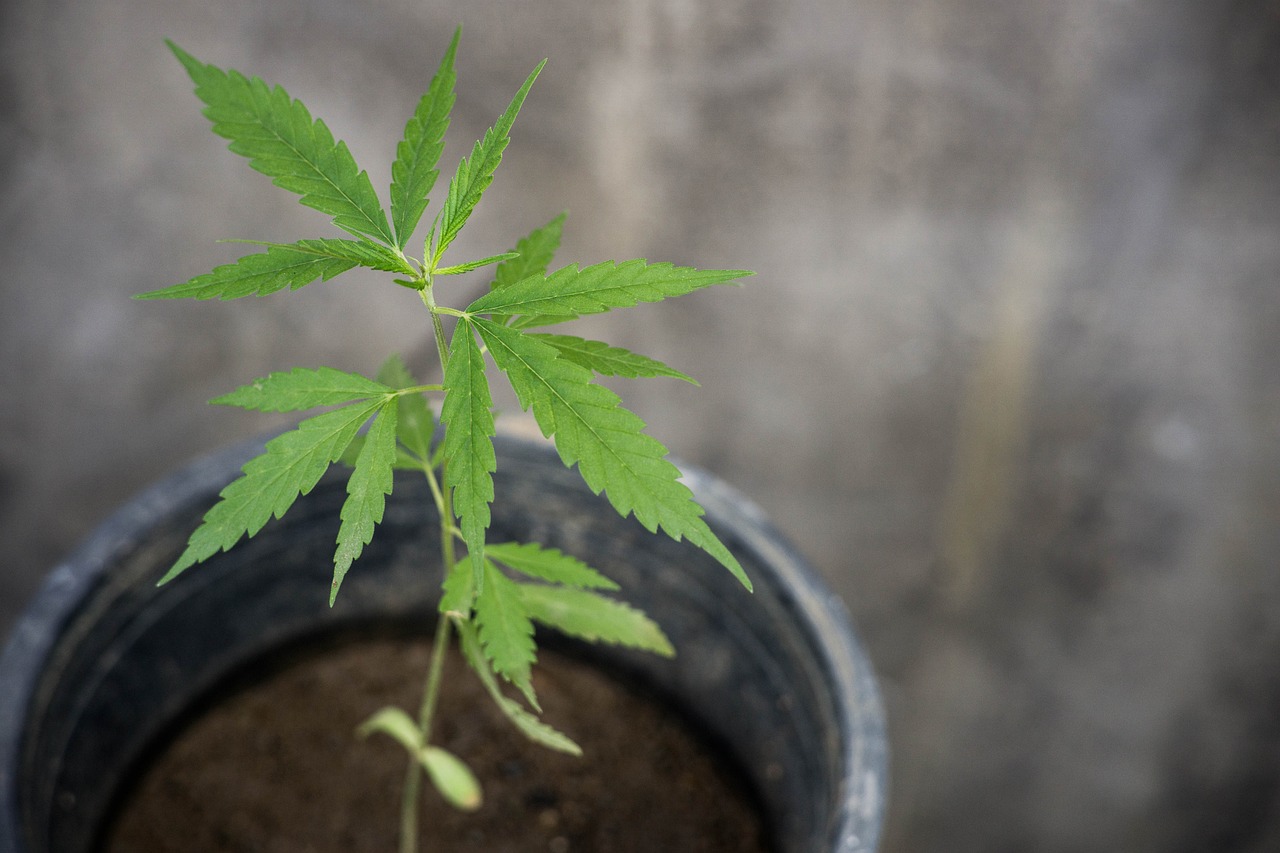
- Indica Strains: Typically, indicas remain shorter and bushier during the vegetative stage, making them suitable for indoor growing or space-restricted environments.
- Sativa Strains: Sativas, on the other hand, tend to grow taller with longer inter-nodal distances. They may require more vertical space, and are often better suited to outdoor cultivation.
- Hybrid Strains: These can exhibit a combination of traits depending on their genetic lineage.
As a grower, understanding your strain’s natural tendencies can help in making informed decisions about plant training, potting, lighting schedules, and other aspects of cultivation.
Key Characteristics of the Vegetative Phase
During the vegetative stage, cannabis plants enter a period of explosive growth. As the main stem elongates, plants put significant energy into developing a broad canopy of leaves, thanks to the process of photosynthesis. Fan leaves are critical here; they act like biological “solar panels,” capturing light and converting it into the energy needed for further growth.
Root Development
While the changes above ground are often the most visible, root development during the vegetative stage is equally important. A healthy, expansive root system ensures that the plant can uptake all the water and nutrients it needs while anchoring it securely in the growing medium. This is why transplanting seedlings into larger containers is a common practice at the beginning of the vegetative phase—it gives the roots the space they need to spread out.
Node Formation
As your cannabis plant continues to grow, you’ll notice the formation of nodes—the points where the branches meet the main stem. These nodes are crucial because they represent the future sites of flower production. The number of nodes developed during the vegetative stage can directly influence the number of buds your plant will produce during flowering.
Internodal Spacing
The distance between nodes, or internodal spacing, can also provide insights into the plant’s health and growth patterns. Sativas typically exhibit longer internodal spacing due to their natural adaptation to tropical climates, while indicas have shorter internodal spacing, contributing to their compact structure. Environmental factors such as light intensity also play a role in determining internodal spacing. Too much space between nodes may indicate the plant is stretching for light, which generally isn’t ideal and may require adjusting your grow lights.
A Week-by-Week Guide to the Cannabis Vegetative Stage
Week 1: Seedling to Early Veg

The journey begins as your seedlings emerge. During this crucial first week, focus on creating an ideal environment for your young plants.
- Provide 18-24 hours of light daily • Maintain temperature at 70-75°F (21-24°C) and humidity at 65-70% • Begin with light feeding of nitrogen-rich nutrients • Monitor for proper root development
Week 2-3: Early Vegetative Growth
As your plants establish themselves, you’ll start to see rapid growth. This is the time to begin implementing training techniques if desired.
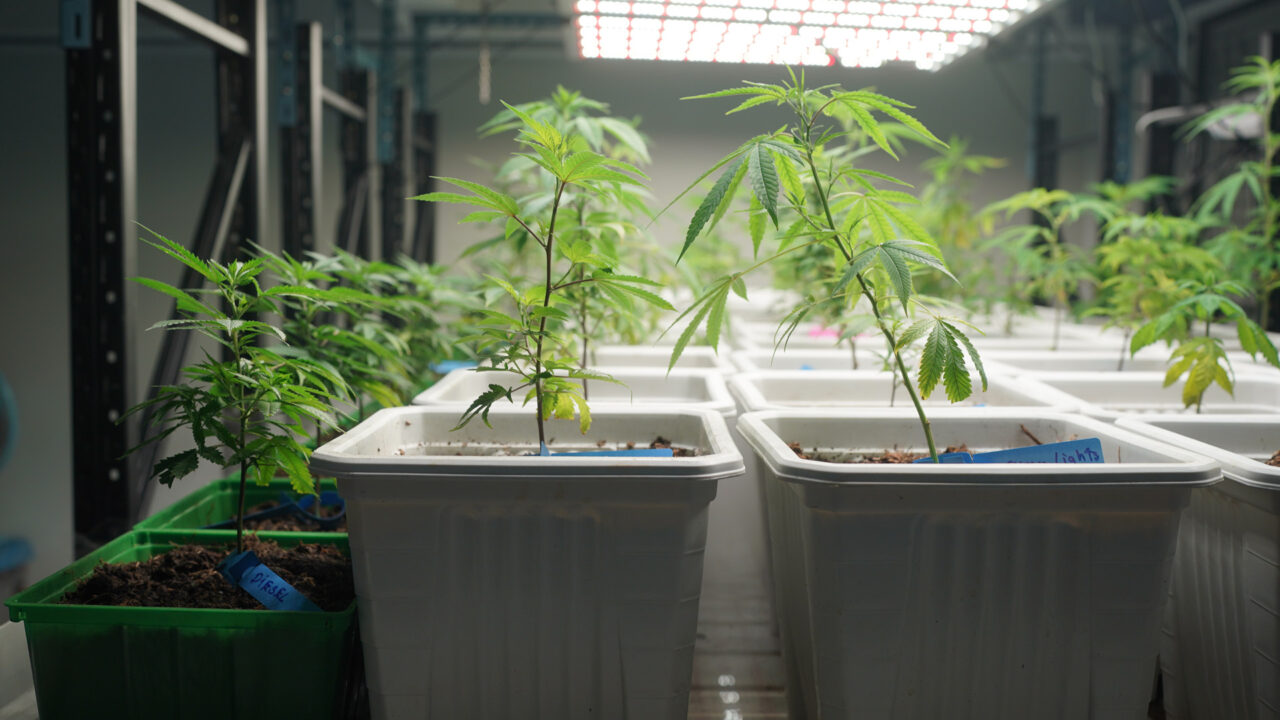
- Continue the 18-24 hour light cycle • Gradually increase nutrient strength to 50% of recommended dose by week 3 • Begin low-stress training (LST) if desired • Consider topping or FIMing for bushier growth in week 3 • Watch for first true leaves to develop and monitor for any nutrient deficiencies
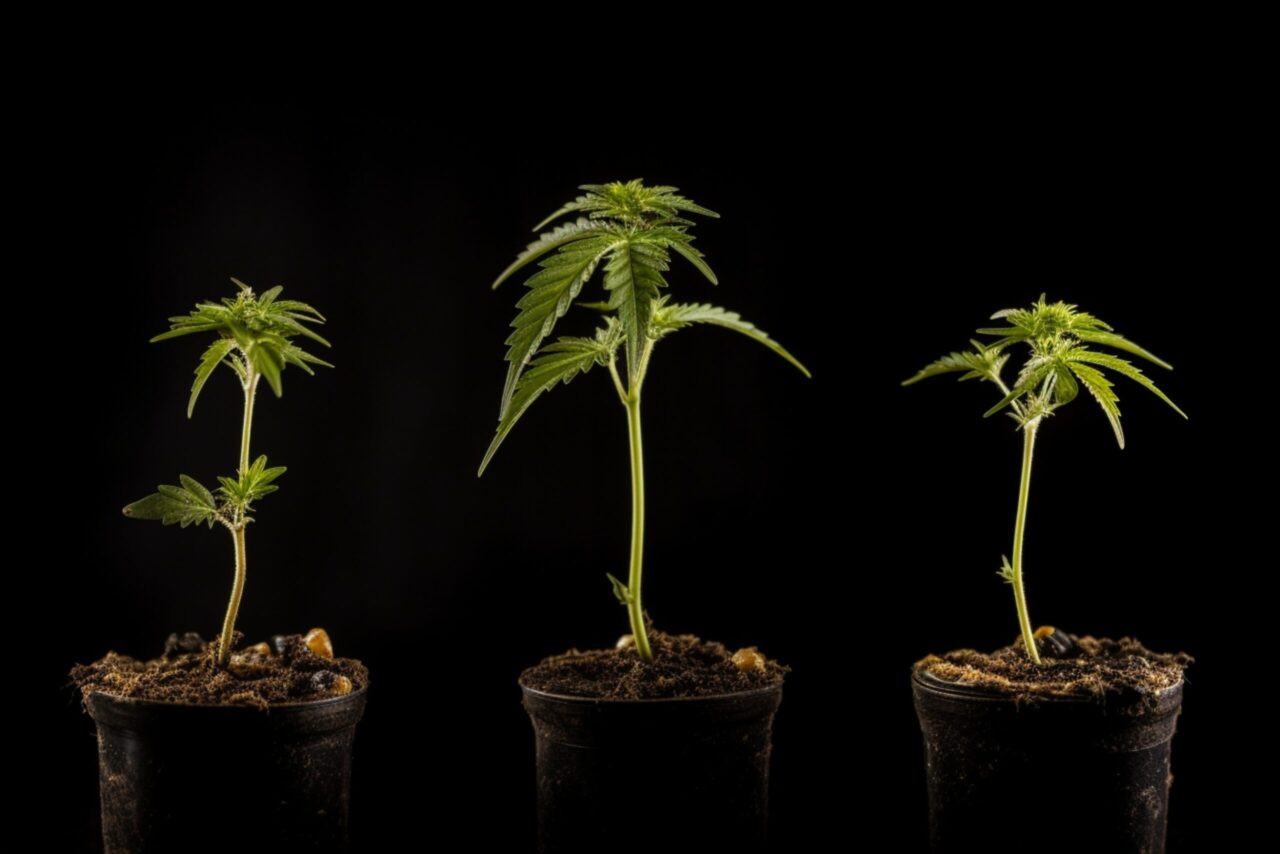
Week 4-5: Rapid Growth Phase
Your plants are now in full vegetative growth. This is a critical period for shaping your plants and ensuring they have everything they need for robust development.
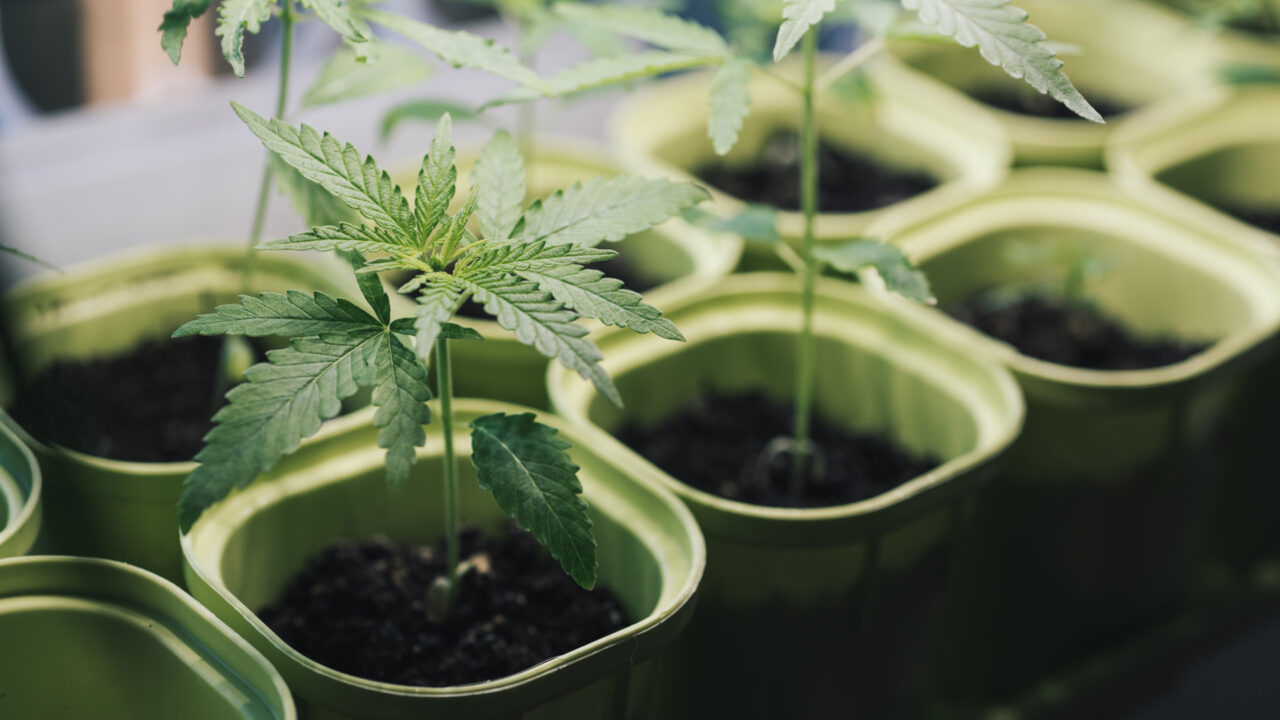
Early vegging weed plants with healthy green leaves.
- Increase nutrients to 75-100% strength • Implement plant training techniques more aggressively • Consider transplanting to larger containers if needed • Prune lower branches for better air circulation • Slightly reduce humidity to 60-65% by week 5
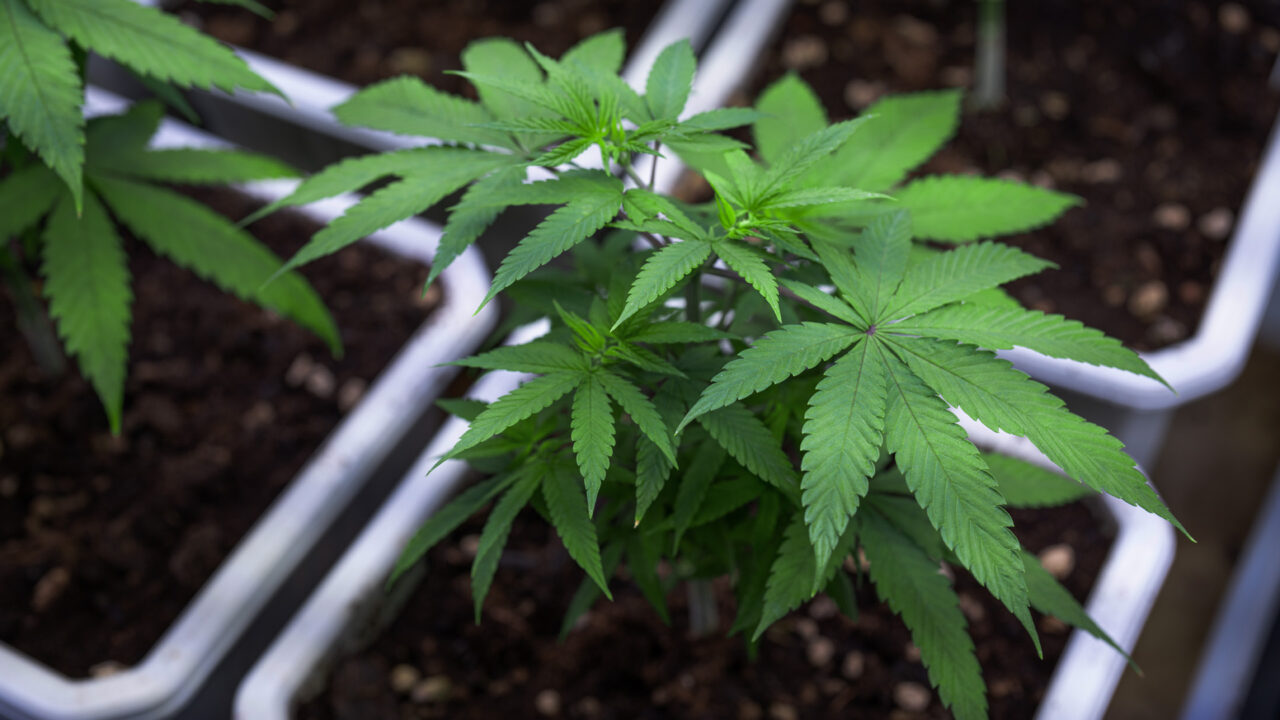
Week 6-7: Late Vegetative Stage
As you approach the end of the vegetative stage, start preparing your plants for the transition to flowering.
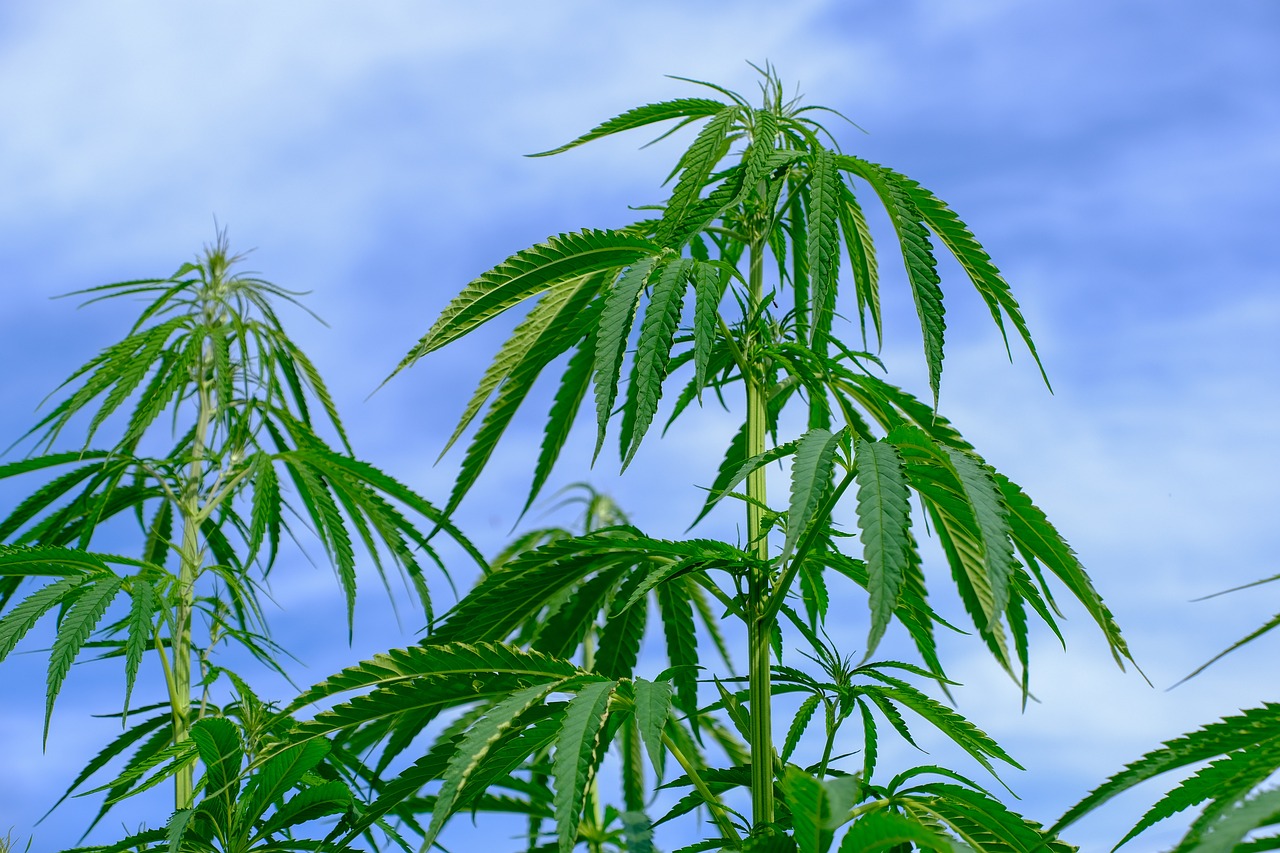
- Begin reducing nitrogen and increasing phosphorus and potassium • Finalize plant structure through training • Consider defoliation to improve light penetration • Reduce humidity to 55-60% • Ensure plants have adequate space for flowering
Week 8: Transition to Flowering
This final week marks the transition from vegetative growth to the flowering stage.
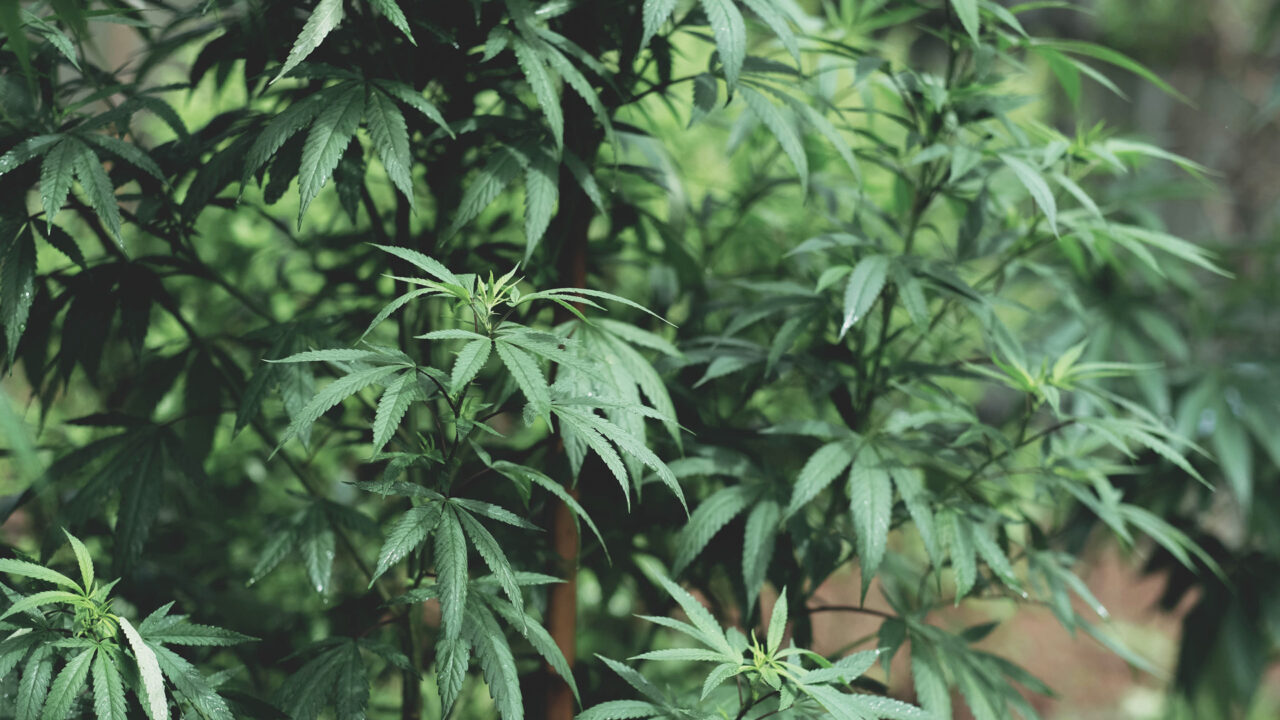
Late cannabis vegetative stage plant growing big and bushy.
- Begin transition to 12/12 light cycle for photoperiod strains • Reduce humidity to 50-55% • Switch to bloom-specific nutrients • Stop all training to avoid stress • Monitor closely for any signs of gender (for non-feminized plants)
Throughout the vegetative stage, it’s crucial to monitor pH levels, ensure proper air circulation, and regularly inspect for pests and diseases. Remember, this guide is general and may need to be adjusted based on specific strains, growing conditions, and desired outcomes. Always observe your plants closely and be prepared to make changes as needed.
Importance of the Vegetative Stage
The vegetative phase serves as the bedrock for a successful harvest. It’s during this time that your cannabis plant will be most receptive to training techniques designed to optimize light exposure, control plant height, and increase overall yields. Additionally, this is when you have the most flexibility in tailoring the plant to meet your specific cultivation goals.
Yes, Size Matters, But Not Always
A critical aspect of the vegetative stage is achieving the right balance between plant size and available growing space. Generally, larger plants with expansive canopies will produce bigger yields. However, achieving this requires space, time, and resources. Growers with limited space may opt to keep their plants smaller but still aim for a high yield by employing training and pruning methods such as topping, low-stress training (LST), and the Screen of Green (ScrOG) technique. This involves manipulating the plant to promote more lateral growth and better light distribution to all budding sites.
Physiological Processes During the Vegetative Phase
Understanding the physiological processes occurring during the vegetative stage helps to appreciate the significance of this period in the cannabis life cycle. Each leaf produced plays a vital role in photosynthesis, converting light, CO₂, and water into sugars that fuel the plant’s rapid growth. Meanwhile, the root system not only anchors the plant but is essential for nutrient and water uptake, supporting everything happening above ground.
By maximizing root health and giving plants the conditions they need to produce a dense canopy, growers ensure their plants are well-prepared to handle the energy demands of flower production. An optimized vegetative stage can lead to better bud quality, higher potency, and more abundant harvests.
Optimizing Your Grow During the Vegetative Stage
Success during the vegetative stage comes down to mastering several key environmental and nutritional factors. Let’s explore these in more detail.
Light Management
Light is the driving force for growth during the vegetative stage. Cannabis plants are phototrophic, meaning they naturally grow towards light to maximize energy absorption. The more light they receive during this phase, the more they can photosynthesize, which in turn leads to faster and more robust growth.
- Light Duration: For photoperiod strains, 18-24 hours of light per day is ideal during the vegetative stage. Some growers prefer 18/6 (18 hours of light and 6 hours of darkness) to give plants a rest period, while others opt for 24 hours of continuous light to maximize growth.
- Light Intensity and Spectrum: The light spectrum also plays a critical role. Blue light (400-500nm) is particularly effective during the vegetative stage as it encourages leafy growth and strong stem development.
Indoor Growing Considerations
Growing indoors gives you almost complete control over the plant’s environment, but with great control comes great responsibility. Maintaining proper light cycles, managing CO₂ levels, and regulating temperature and humidity are all essential for vigorous vegetative growth.
- Light Setup: LED, HID, and fluorescent lights are popular choices among indoor growers. LEDs, in particular, are energy-efficient and offer customizable spectrums that can be tailored to the needs of the vegetative stage.
- Temperature and Humidity: Ideal temperatures during the vegetative phase range from 20-30°C (68-86°F). Humidity levels should be kept relatively high—around 50-70%—to facilitate transpiration without encouraging mold growth.
Environmental Control Tools
Given the importance of light, temperature, and air quality, indoor growers should consider investing in:
- Fans: To ensure adequate airflow and oxygen distribution while preventing heat buildup.
- Hygrometers and Thermometers: For monitoring humidity and temperature.
- Humidifiers/Dehumidifiers: To maintain the optimal moisture level in the air.
- CO₂ Generators: To enhance photosynthesis, boosting growth rates and yields.
Outdoor Growing Considerations
Outdoor cannabis growing relies more on natural cycles, which can be both an advantage and a challenge. Weather, pests, and limited control over light cycles must all be managed effectively.
- Light Availability: Outdoor growers should aim to position plants in areas that receive at least 8 hours of direct sunlight per day. Natural sunlight provides the full spectrum of light, making it ideal for vegetative growth.
- Pest Control: Outdoor plants are more susceptible to pests and animals. Strategies to manage these include natural predators, companion planting, and physical barriers such as netting or fencing.
Environmental Impact
Outdoor growers should consider that their plants may be exposed to fluctuating environmental conditions. Heatwaves, unexpected cold snaps, or extreme humidity can all stress the plants, potentially stunting their growth or making them more susceptible to diseases and pests. Monitoring local weather patterns and being prepared to act—whether by providing shade, extra water, or shelter—can mitigate these risks.
Nutrient Management in the Vegetative Stage
Proper feeding during the vegetative stage is critical to achieving vigorous growth. Cannabis plants have specific nutrient requirements that differ between the vegetative and flowering phases.
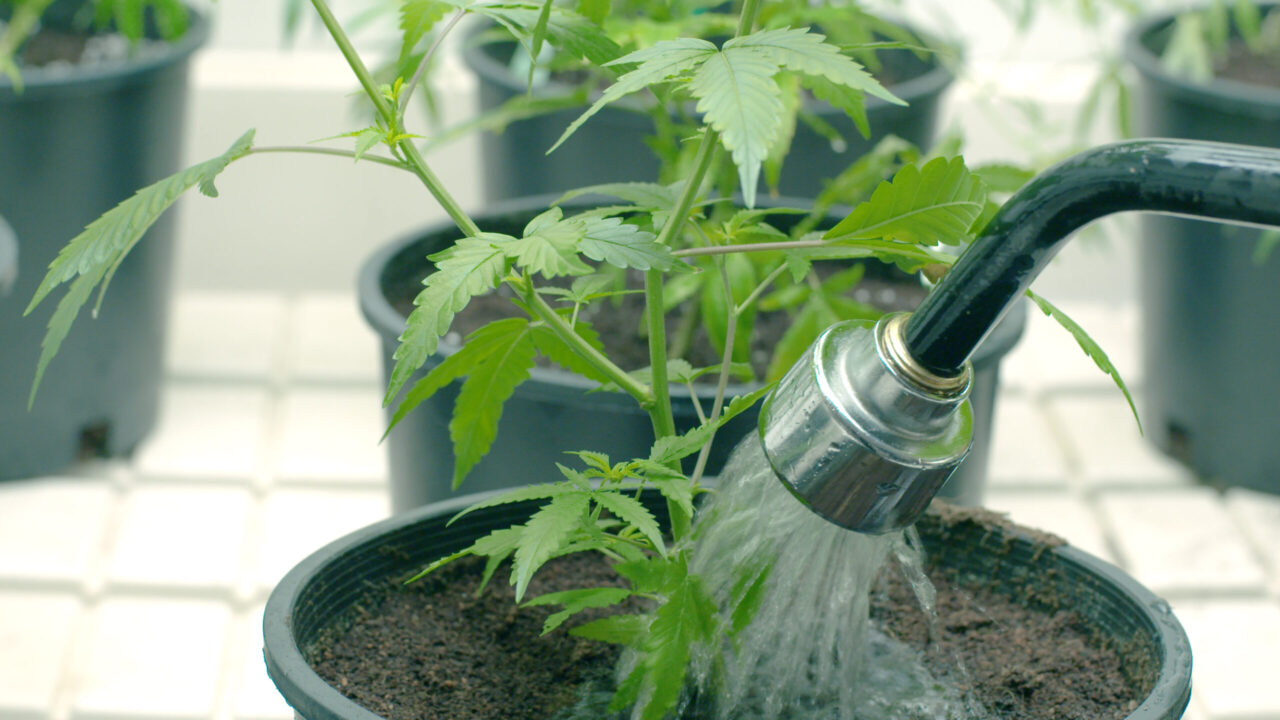
The Role of Key Nutrients
- Nitrogen (N): This is the primary nutrient needed during the vegetative stage. Nitrogen is a crucial component of chlorophyll, the molecule that enables photosynthesis. It also supports the development of leaf and stem structures.
- Phosphorus (P): This nutrient is pivotal for root development and energy transfer, though it’s more critical during the flowering phase.
- Potassium (K): While more integral during flowering, potassium aids in regulating the plant’s water balance and activating enzymes required for growth.
- Magnesium (Mg) and Calcium (Ca): These secondary nutrients support various physiological functions, including photosynthesis and cell wall stability.
Nutrient Formulas
Many growers prefer to use pre-formulated nutrient solutions designed specifically for the vegetative stage. These are often labeled as “Grow” formulas and tend to have a higher nitrogen content. It’s important to follow the manufacturer’s guidelines closely, as over-fertilizing can lead to nutrient burn.
- Organic vs. Synthetic Nutrients: Organic nutrients come from natural sources and can improve soil health over time, while synthetic nutrients provide immediate access to the essential elements but require careful pH monitoring.
Watering Best Practices
Watering can be a seemingly simple task, but improper watering practices can lead to significant plant health issues.
Water Quality
The quality of the water you use is just as important as the amount. Tap water may contain chlorine, chloramine, and other chemicals that can harm beneficial soil microorganisms or disrupt nutrient uptake. Many growers opt for filtered water or use water conditioners to remove these unwanted elements.
Watering Frequency and Technique
- Soil Grows: As a rule, wait for the top inch or so (about 3cm) of soil to dry out before watering again. Over-watering can lead to root rot, nutrient lockout, and other problems, while under-watering can stress the plant.
- Hydroponic Grows: In hydroponic systems, plants are constantly exposed to water, so care must be taken to avoid root rot by properly managing oxygen levels and nutrient concentrations.
- The Importance of Drainage: Proper potting is essential to avoid waterlogging. Ensure your containers have adequate drainage holes, and use a well-aerated soil mix.
Training Techniques During the Vegetative Stage
The vegetative stage provides an excellent opportunity to begin training your cannabis plants. Training can help control the size of the plant, improve light exposure to all areas, and increase the number of bud sites, resulting in a higher yield.
Topping and FIMming
- Topping: This involves cutting off the top of the main stem after the plant has developed several nodes. Topping causes the plant to grow multiple colas (main flowering sites) rather than one dominant cola. The cut should be made just above a node to encourage the growth of two new main stems.
- FIMming (Fk I Missed):** Similar to topping, FIMing is a technique where only a portion of the main stem—about 75%—is snipped off. This method can result in more than two new colas and less stress on the plant compared to topping.
Low-Stress Training (LST)
Low-stress training involves gently bending and tying down branches to create a more even canopy, thereby improving light penetration and airflow. This technique is particularly useful for growers who want to maximize yield without increasing the height of the plant significantly.
- Starting LST: Begin LST when the plant has at least three nodes. Use soft ties to secure the branches in place, and adjust as the plant grows.
- Benefits: LST can lead to an increase in the number of bud sites and improve overall plant health by allowing better air circulation.
The Sea of Green (SOG) Technique
The Sea of Green technique involves growing many small plants in close proximity, creating a horizontal “sea” of colas. This method is often used to maximize yield in a smaller growing space, typically with faster maturing strains.
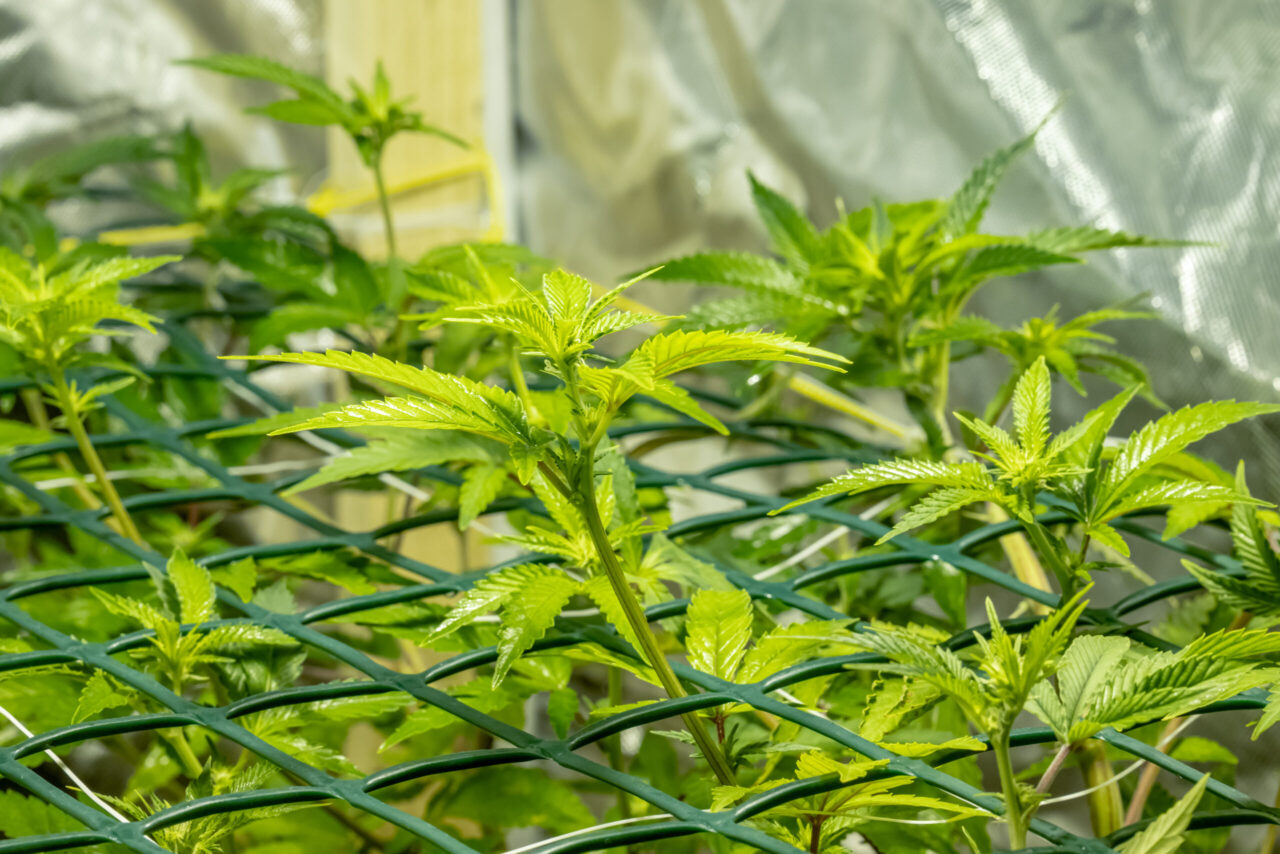
- Setup: Small containers are used to house each plant, and the vegetative stage is kept short—around 2-3 weeks—before flipping the plants to flower. Regular pruning ensures that energy is focused on the top colas, resulting in dense, uniform buds.
Screen of Green (ScrOG) Technique
ScrOGging involves using a screen or net to spread out the top of the plant canopy horizontally. As the plant grows through the screen, it is trained to grow outward rather than upward, increasing light exposure to lower nodes and improving overall yield.
- Ideal Timing: ScrOGging is most effective when started early in the vegetative stage to ensure plants have enough time to fill out the screen before flowering begins.
- Maintenance: Regular pruning below the screen helps direct energy to the top bud sites and prevents lower growth from becoming shaded.
Pest and Pathogen Management
One of the biggest threats during the vegetative stage is the potential for pest and pathogen outbreaks. Being proactive in pest management will help ensure a healthy grow.
Common Pests
- Spider Mites: These tiny pests can proliferate quickly, causing stippling on leaves and eventually leading to plant death if left unchecked. Mitigation strategies include regular monitoring and the use of organic pest control products or beneficial insects like ladybugs.
- Fungus Gnats: Fungus gnats are attracted to moist, fertile soil and can cause root damage. Yellow sticky traps, neem oil drenches, and better watering practices can deter these pests.
- Aphids: Aphids feed on the sap of cannabis plants and can quickly overrun a grow operation if not controlled. Insecticidal soaps or neem oil can be effective in controlling their population.
Common Diseases
- Powdery Mildew: A fungal disease that appears as a white powdery substance on leaves, often due to high humidity levels. Preventative measures include proper airflow, lower humidity levels, and the use of sulfur-based fungicides.
- Root Rot: Typically caused by over-watering and poor drainage, this disease leads to browning of the roots and wilting of the plant. Ensuring proper watering techniques and using well-draining soil can prevent root rot.
Integrated Pest Management (IPM)
Integrated Pest Management is a holistic approach to managing pests and diseases that combine biological controls, cultural practices, and mechanical means.
- Prevention: Keep your grow area clean, avoid overwatering, and regularly inspect plants for signs of pests or disease.
- Beneficial Insects: Introducing beneficial insects such as ladybugs or predatory mites can help keep pest populations in check without the need for chemical interventions.
Final Thoughts and Preparing for the Transition to Flowering
As the vegetative stage draws to a close, it’s important to prepare your cannabis plants for the transition to the flowering phase. This involves adjusting your light cycle (for photoperiod strains), tweaking your nutrient profiles, and ensuring that your plants are as healthy as possible before they start to flower.
Light Cycle Adjustment
For photoperiod strains, the end of the vegetative phase is marked by a shortening of the light cycle to 12/12 (12 hours of light and 12 hours of darkness). This triggers the plant to enter the flowering stage.
Pre-Flowering Nutrient Adjustments
As you make the transition to flowering, you’ll want to start introducing nutrients with higher phosphorus and potassium levels, while gradually reducing nitrogen. This helps prepare the plant for the energy-intensive process of flower production.
Final Training and Pruning
Any final training, such as topping or LST, should be completed before flowering begins to avoid stressing the plant during this critical time. Pruning should focus on removing any lower leaves that may not receive adequate light, redirecting energy to the top of the plant where the main colas will form.
The Key to a Successful Harvest Begins with the Vegetative Stage
The vegetative stage is more than just a precursor to flowering; it is the foundation upon which your entire grow is built. Mastering the intricacies of this stage— from proper light management and nutrient utilization to effective training and pest control— can make the difference between an average yield and a truly exceptional one.
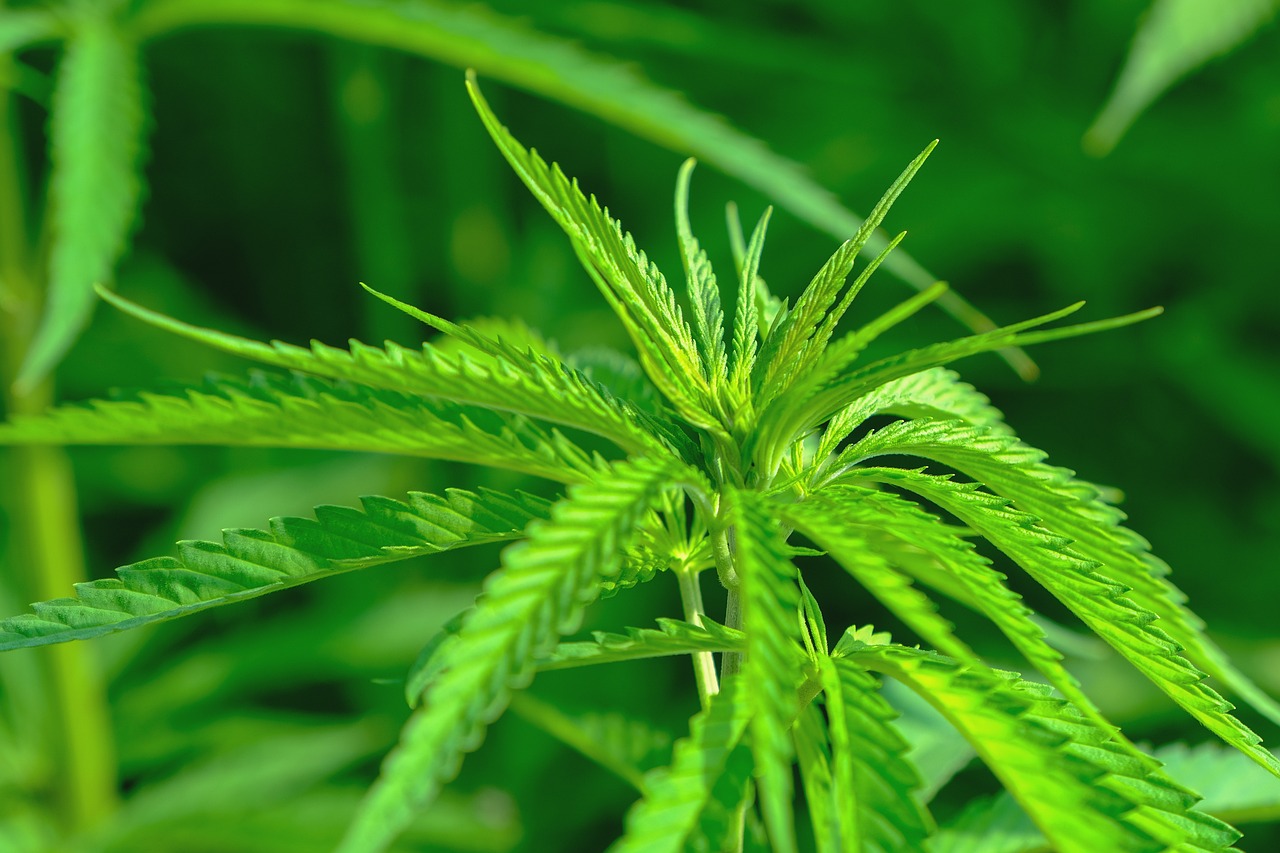
By arming yourself with the knowledge and strategies outlined in this guide, you position yourself to grow strong, healthy cannabis plants that are capable of producing an abundant, potent harvest. Whether you’re a novice grower or a seasoned cultivator, the vegetative stage is your opportunity to set the stage for success. Embrace this critical phase, and you’ll be well on your way to achieving the best results possible in your cannabis horticulture endeavors.
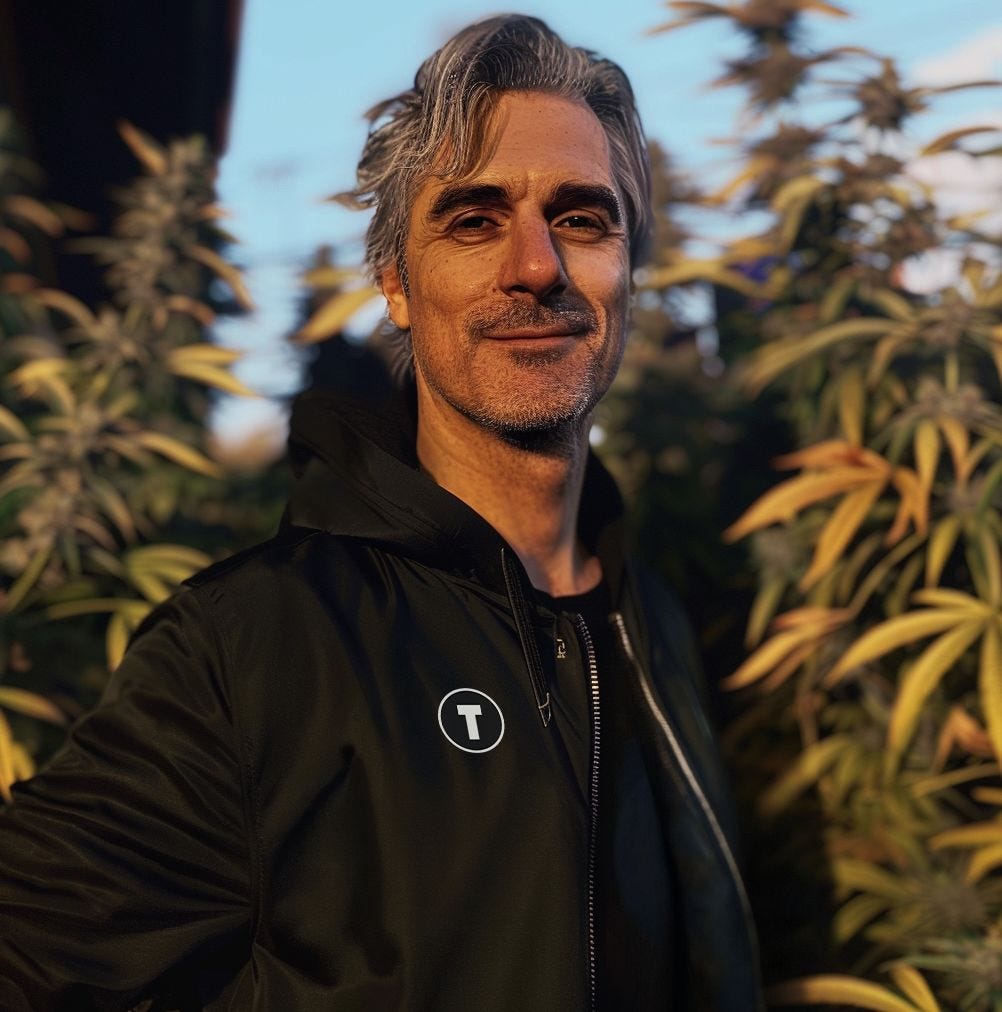
Mike Titan, the founder of Titan Seeds, is a seasoned cannabis cultivator and the mastermind behind the comprehensive grow guide available on the Titan Seeds website.



